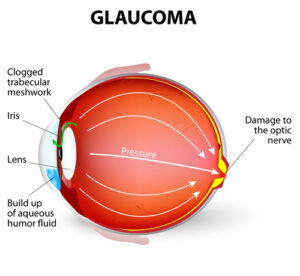Glaucoma is one of the leading causes of blindness in adults who are 60 and older. You may have heard it called the “Secret Thief” or “Silent Thief” of sight. This is because many people develop glaucoma and don’t even know it until it’s too late.
Glaucoma causes permanent damage to the optic nerve, which is a vital part of your eye. When the optic nerve becomes seriously damaged, it causes vision loss.
Glaucoma often goes unnoticed because it doesn’t present any symptoms in the early stages of the eye condition. The first symptoms in almost all cases of glaucoma only occur once the optic nerve has become damaged enough to cause vision loss.
At that point, there is no way to repair the damage, making it impossible to regain any vision lost. The good news is that even if you have glaucoma, it doesn’t have to mean the total loss of your vision. Keep reading to learn about glaucoma, how it affects your vision, and why it’s called the secret thief of sight!
What is Glaucoma?

Glaucoma refers to the name given to a group of eye conditions that cause damage to the optic nerve. Almost all forms of glaucoma are caused by high intraocular pressure or IOP.
Intraocular pressure increases if aqueous fluid cannot flow freely in the eye. The reason for this is because of a blockage in the eye.
Open-Angle Glaucoma
The most common form of glaucoma is called open-angle glaucoma. The angle referred to is the primary drainage angle between the cornea and the iris.
In cases of angle-closure glaucoma, which is much rarer, the iris bulges and closes off this angle, causing a fast build-up of intraocular pressure. But in open-angle glaucoma, fluid can still flow through this channel.
It gets blocked, however, by the other drainage channels surrounding the eye. These channels, called the trabecular meshwork, can become obstructed.
This form of glaucoma develops very slowly as more trabecular meshwork becomes blocked off, gradually raising intraocular pressure.
Open-angle glaucoma doesn’t cause pain but strains the optic nerve as your intraocular pressure rises. Eventually, this strain damages the optic nerve and causes vision loss.
What are the Symptoms of Glaucoma?
There are no symptoms in the early stages of open-angle glaucoma. Angle-closure glaucoma presents symptoms because it happens suddenly.

These include severe headaches, eye pain, blurred vision, nausea, and vomiting. Prompt medical treatment can relieve this sudden build-up of pressure and save your eyesight, so seek emergency care if you experience these symptoms.
As for open-angle glaucoma, the only symptoms begin when the optic nerve has already become irreparably damaged. You’ll experience vision loss starting with your peripheral vision.
You may notice that your peripheral vision is blurry or completely dark. Over time, you’ll lose more and more of your peripheral vision, causing tunnel vision. Eventually, left untreated, glaucoma will lead to total blindness.
However, you don’t have to go blind if you have glaucoma. You can receive a diagnosis and treatment before you develop symptoms. The only way to do this is by scheduling eye exams regularly.
When to Have Eye Exams
Once you reach a certain age, you should start to have comprehensive eye exams. Several age-related eye conditions can affect your vision, including glaucoma.
While glaucoma doesn’t show any symptoms in the early stages, there are signs that an eye doctor can find by conducting an eye exam. You must have eye exams annually if you wear glasses or contact lenses.
If you are at an increased risk for eye conditions or have other eye concerns, you should talk to your eye doctor about an appropriate schedule for eye examinations. Even if you think your eyes are healthy, you need eye exams at least once every year or two after turning 40.
You’re at higher risk for glaucoma if you:

- Have high blood pressure
- Have diabetes
- Have a family history of eye conditions
- Have thin corneas
- Have had previous eye injuries or surgeries
- Are very nearsighted
- Are of African, Hispanic, or Asian descent
If you exhibit any of these risk factors, you may need to see an eye doctor more often for exams. Talk to your eye doctor about your risk for glaucoma and other eye conditions. They can recommend how often you need eye exams.
How Do You Treat Glaucoma?
Undergoing a comprehensive eye exam at New England Eye Center can diagnose and spot glaucoma in its early stages. This is usually done by measuring your intraocular pressure and using imaging devices to examine your optic nerve for damage.
The earlier you’re diagnosed with glaucoma, the better. Although there is no cure for glaucoma, it is treatable. Treatment can slow down its progress, preserving your vision for many years.
There are several treatment options for glaucoma. Depending on your particular case of glaucoma, your ophthalmologist may recommend a combination of treatments:
Medication

Medication for glaucoma usually comes in the form of prescription eye drops that lower intraocular pressure. Even if your intraocular pressure is elevated, you may have these eye drops prescribed, but you haven’t developed glaucoma yet. Medication may prevent you from developing glaucoma for some time in these cases.
Laser Treatment
Laser therapies for glaucoma are less invasive than surgery. There are several kinds of laser treatments, but most use a laser shined through your eye to target the trabecular meshwork. The laser helps open the trabecular meshwork, enabling fluid to flow better and lowering intraocular pressure.
Surgery
For more severe glaucoma, surgery may be necessary. There are different kinds of glaucoma surgery.
Some require making a small opening in the eye. Some include implanting a drainage device.
Some surgeries are MIGS, which are Minimally Invasive Glaucoma Surgeries. MIGS procedures use tiny devices and other techniques to minimize healing time after surgery.
MIGS is best for mild to moderate glaucoma, though. Advanced glaucoma usually requires traditional glaucoma surgeries.
Learn more about the best ways to treat glaucoma by requesting an appointment at New England Eye Center in Boston, MA!
